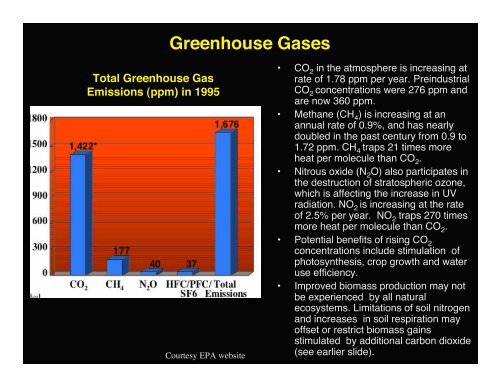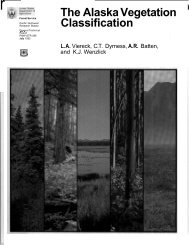Lesson 32 Mineral Cycling - Alaska Geobotany Center
Lesson 32 Mineral Cycling - Alaska Geobotany Center
Lesson 32 Mineral Cycling - Alaska Geobotany Center
Create successful ePaper yourself
Turn your PDF publications into a flip-book with our unique Google optimized e-Paper software.
Greenhouse Gases<br />
Total Greenhouse Gas<br />
Emissions (ppm) in 1995<br />
Courtesy EPA website<br />
• CO 2 in the atmosphere is increasing at<br />
rate of 1.78 ppm per year. Preindustrial<br />
CO 2 concentrations were 276 ppm and<br />
are now 360 ppm.<br />
• Methane (CH 4 ) is increasing at an<br />
annual rate of 0.9%, and has nearly<br />
doubled in the past century from 0.9 to<br />
1.72 ppm. CH 4 traps 21 times more<br />
heat per molecule than CO 2 .<br />
• Nitrous oxide (N 2 O) also participates in<br />
the destruction of stratospheric ozone,<br />
which is affecting the increase in UV<br />
radiation. NO 2 is increasing at the rate<br />
of 2.5% per year. NO 2 traps 270 times<br />
more heat per molecule than CO 2 .<br />
• Potential benefits of rising CO 2<br />
concentrations include stimulation of<br />
photosynthesis, crop growth and water<br />
use efficiency.<br />
• Improved biomass production may not<br />
be experienced by all natural<br />
ecosystems. Limitations of soil nitrogen<br />
and increases in soil respiration may<br />
offset or restrict biomass gains<br />
stimulated by additional carbon dioxide<br />
(see earlier slide).
















